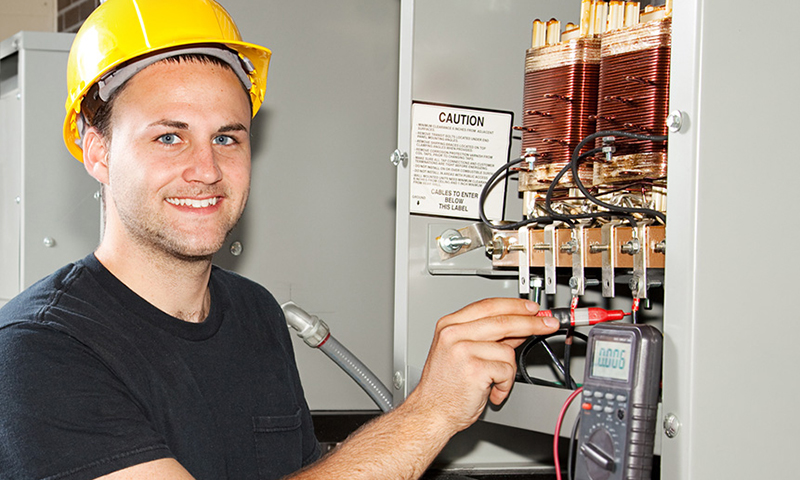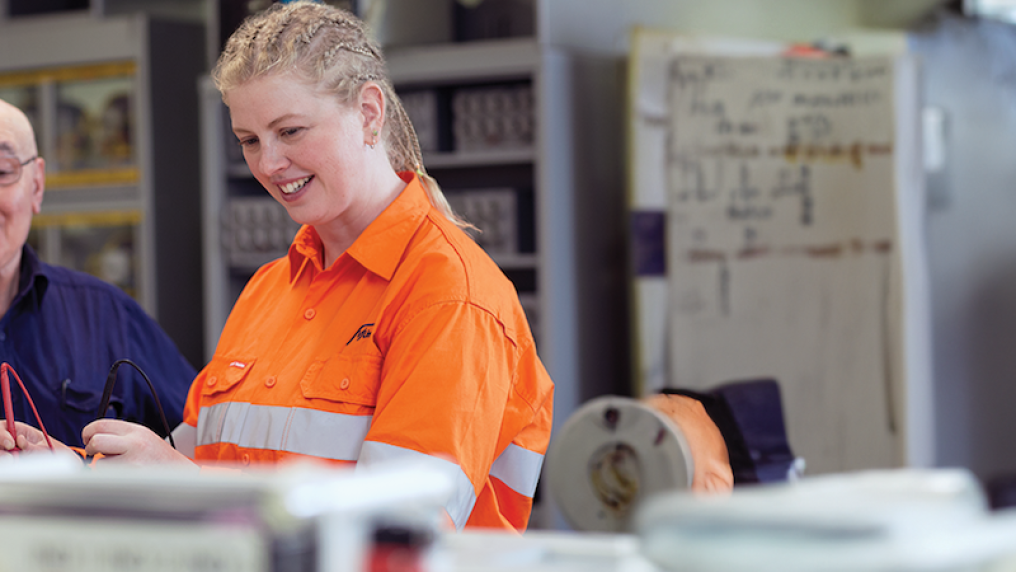How to become an electrician – the ins & outs of an electrotechnology apprenticeship
Becoming an electrician means opening doors to diverse job opportunities, high job demand and great pay.
Kick off your career at Victoria University (VU) with on-the-job training through an electrical apprenticeship as part of a free TAFE course*.
* Free TAFE is available to eligible students only. Free TAFE courses are free of tuition fees, but student services and materials fees still apply.

What do electricians do?
Some common things you learn as an electrical apprentice include how to:
- install electrical, electronic or telecommunication systems and equipment
- maintain equipment and systems through inspections, testing and troubleshooting
- diagnose and repair faults in electrical systems, components and equipment
- follow safety procedures, protocols and regulations
- interpret technical blueprints, diagrams and schematics for electrical systems
- comply with relevant codes, standards, and regulations that govern the installation and maintenance of electrical, electronic and telecommunication systems.
Keep in mind: every apprenticeship is different and can be tailored for certain specialities, whether that’s residential installations, commercial and industrial maintenance, telecommunications, events, renewable energy or air conditioning and refrigeration.
Signs you’d be a good electrician
Wondering if being an electrician is a good fit for you? Here are some of the skills, strengths and attributes that’ll help you succeed:
- you enjoy technical work and have great attention to detail
- you enjoy troubleshooting problems and finding solutions
- you’re adaptable and willing to learn new things in an ever-evolving industry
- you have basic math skills so you can measure currents, volts and lengths of cables
- you enjoy doing different kinds of work in all different places
- you don’t mind working in confined spaces or at heights
- you’re willing to interpret complex diagrams and blueprints
- you're reasonably fit and dexterous
- you have good safety awareness and a willingness to follow strict regulations
- you have great communication skills for interacting with clients, co-workers and supervisors.
What’s the path to become an electrician?
If you’re looking to start with a pre-apprenticeship, you can apply for a TAFE course directly at VU. The pre-vocational Certificate II in Electrotechnology 22682VIC is a practical, 4-month, full-time course that equips you with the foundational skills and knowledge to choose your career path in the electrical and electronics industry.
You’ll learn all about:
- basic electrical theory and workshop practices
- basic network cabling for extra low voltage (ELV) equipment and devices
- use of test instruments in the electrotechnology industry
- wiring and installation
- providing basic sustainable energy solutions in domestic premises
- fabricating, assembling and dismantling utility industry components
- working with electrotechnology equipment and use of test instruments
- workplace safety and first aid.
Study your Cert II full-time for 4 months or part-time over 2 years if you are taking the course as part of Vocational Education and Training Delivered to Secondary Schools (VDSS). You’ll graduate ready to start an electrical apprenticeship or traineeship.
Getting started with an electrical apprenticeship
Once you complete the pre-apprenticeship course, you apply for your electrical apprenticeship using the following steps. VU staff can offer guidance if you need any extra help managing this process.
1. Find your employer
Look for an employer who’s keen to take on an apprentice or trainee. You can find these on job boards like Seek and government career sites. Sign up for alerts using terms that match your goal, like 'electrician apprentice'.
You apply for apprenticeships just like you would any ordinary job. You can also find opportunities through group training organisations (GTOs), who employ apprentices, then match them with suitable employers.
2. Connect with an apprentice agency
Your employer then arranges the necessary contracts and agreements with an Apprentice Connect Australia Provider. These government-appointed agencies also offer guidance and support during your apprenticeship.
3. Enrol at VU
Once you accept an apprenticeship offer, we'll work with your employer to talk about your training details and get you enrolled in the Certificate III in Electrotechnology Electrician UEE30820 at VU. This 4-year, part-time course covers the fundamentals of the electrical trade, complete with hands-on learning experiences.
You’ll learn how to:
- use hand and power tools
- fabricate industry components
- install and maintain single and multiple path circuits
- apply technical drawings and diagrams
- install and maintain low voltage heating equipment and socket outlets
- design and install switchboards and installations
- install and maintain magnetic and electromagnetic devices
- troubleshoot electrical issues
- install and maintain wiring systems for network communications
- follow work health and safety practices.
You’ll learn how to manage all the phases of electrical systems and equipment, from installation and set up to testing, fault finding and conducting repairs in line with the Electrical Regulatory Authority Council’s requirements.
4. Create your training plan
VU works with you and your employer to develop a training plan, looking at things like how often you go to class at VU. Depending on what you and your employer prefer, this can range from one day a week to week-long blocks of training at different times.
5. Begin working & studying!
Once your application is all done, you’ll start your training plan, attending work and classes. When you pass all the knowledge and skills assessments and complete the on-the-job work components of the course, we’ll issue you the Certificate III in Electrotechnology Electrician UEE30820.
Becoming a licensed electrician
Once you complete the Cert III, you can apply to become a licensed electrician through Energy Safe Victoria. This involves passing the Licensed Electrician's Assessments (LEA), which covers theory, practical work and safety. You need a result of 75% or more to pass each assessment.
You’ll need to provide a letter from VU that says you’ve completed all the required units of competence and can attempt an LEA. You'll also need a letter from your employer/s stating you’ve got at least 12 months experience carrying out electrical installation work. Once you meet all the requirements and pass the assessments, you’re good to go!
How much do electricians get paid?
Wondering how much you could make working as an electrician? Here’s a quick state-by-state guide:
| State/territory | Average salary range for a licensed electrician |
|---|---|
| New South Wales | $85,000—$100,000 |
| Northern Territory | $100,000—$120,000 |
| Queensland | $85,000—$105,000 |
| South Australia | $90,000—$100,000 |
| Tasmania | $90,000—$105,000 |
| Victoria | $90,000—$105,000 |
| Western Australia | $110,000—$130,000 |
Keep in mind: how much you make as an electrician varies a huge amount. It all depends on things like your experience level, speciality and whether you’re self-employed or work for a company.
[Source: Seek 2025]
Choose your unique career path as an electrician
Depending on your interests and skill-set, you can choose a variety of different career paths once you become a licensed electrician. You can be a self-employed tradesperson, work in-house at a small or large company, or become an external contractor or consultant.
You could also look at studying or training further or entering specific industries like manufacturing, telecommunications, construction, mining or events. It’s up to you! Choose the path that best fits your lifestyle and long-term goals.
Ready to get started?
Kick-start your career as an electrician with a TAFE course at VU:
Apply for the Certificate II in Electrotechnology (Pre-vocational) 22682VIC
Apply for the Certificate III in Electrotechnology Electrician UEE30820
VU stories
